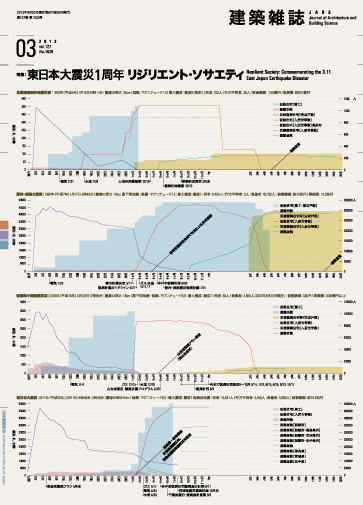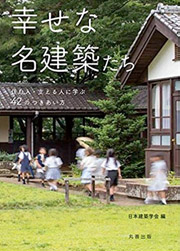本文PDFの閲覧につきましては、こちらでご確認ください。

2012-3月号 MARCH
特集= 東日本大震災1周年 リジリエント・ソサエティ
Resilient Society: Commemorating the 3.11 East Japan Earthquake Disaster
特集前言 リジリエンスというメッセージ
まず確認すべきは、災害は(たとえ自然災害であっても)社会が生み出す現象だということである。人が住まないところに災害はなく、社会が異なれば災害の様相も規模も異なる。 災害は、構造物のみならずコミュニティや個人が受けるダメージも含むものであり、地震や津波に襲われたそのときに終わるのではなく、時間の進行とともに継起的に変化し、長期的に拡大することもある。社会の脆さは脆弱性(vulnerability)という概念で扱われる。 しかし、壊れにくくすることには限界がある。そこで社会がそなえるしなやかな復元=回復力を意味するリジリエンス(resilience)という概念が、脆弱性概念に連接するかたちで浮上してくる。脆弱性を小さくすればリジリエンスも発揮されやすくなるというように、この二つの概念には相補的な側面がある。 では社会のリジリエンスが高いとはどういうことか。頑強性(Robustness)・冗長性(Redundancy)・甲斐性(Resourcefulness)・迅速性(Rapidity)の4Rが指摘されているが、実際の地域社会でこれらは何に相当するのか。 もうひとつ。災害直前の社会の状態をAとし、災害を受けた社会の状態をA′とするとき、一般に復興はA′→Aというように元どおりに戻ることではなく、次なる平衡状態A″へとダイナミックに変化を遂げることだろう。この変化は、一般に災害前に社会に潜在していた諸矛盾や利害関係を背景とするが、地域社会はそれらを踏まえつつ幾度も決断を重ねて復興の道を歩む。
本特集では、東日本大震災一年を迎えるにあたり、被災各地の復興へ向けた動きとその背景・実情を捉えながら、急激に専門家のあいだに広まった感のある「リジリエンス」という概念についても考えることにした。 被災地の風景はいまだ荒涼としており、復興には今後も長い年月を要する。現段階で被災地のリジリエンスを考えるのは難しいだろう。しかし、目的地も経路も刻々と変化していく不安定な道のりの上にあっても、地域社会が発揮しうる複雑な能力に目を凝らしつつ実践と制度を組み立てよというメッセージが、リジリエンスという言葉には含まれるのではないか。
本号では特集に先立ち、佐藤直良氏(国交省技監)と和田章氏(日本建築学会長)による特別対談を掲載した。特集からは独立した記事であるが、リジリエンスというテーマにも豊かな示唆を与えていただいている。 特集第1部の座談会では、東日本大震災の復興をめぐって、隈研吾、佐土原聡、中島正愛、藤井聡、布野修司の諸氏に幅広い議論を展開していただいた。治癒力の最大化を軸としつつ、グローバル経済に接続した東北の脆弱性やエネルギー問題、社会的弱者への視点、国家の役割など多岐にわたる論点を引き出せる。 ところでシステムの脆弱性や回復力については、20世紀後半にさまざまな分野で探求されてきたが、リジリエンス概念をめぐる理論的・実証的研究は、近年になって精神医学・心理学、コンピュータサイエンス、環境研究、災害社会学などの分野で方法的に積み重ねられている。そこで浦野正樹(災害社会学)、島田周平(アフリカ地域研究)、小花和・ライト・尚子(発達心理学)の各氏に各専門領域での議論のフレーム、研究方法などについて概説いただき、東日本大震災にも貴重な示唆を与えていただいた。 第2部の公開パネルディスカッションは、被災地の現場にあって復興支援に携わる諸氏に、各被災地再生のプロセスと問題点や可能性を提示していただいたうえで討議した。実際の被災地の実情に即して、リジリエンスを決める要因を具体的に抽出する貴重な試みとなった。 つづく第3部では、日本の他地域や海外にも視野を拡げ、奥尻島(北海道南西沖地震津波)、アチェ(スマトラ沖地震津波)、神戸(阪神・淡路大震災)、ニューヨーク(アメリカ同時多発テロ事件)、四川省(中国汶川地震)といった事例の検討と、災害復興をめぐる物保険の役割に関する論考をまとめた。極端なまでに様相を異にする世界の事例からは、復興がその社会の特質をいかに如実に示すものであるかを思い知らされる。
会誌編集委員会
本号編集担当:牧紀男(京都大学防災研究所)・寺川政司(近畿大学)・竹内泰(宮城大学)
[目次]
| 000 | 連載 再建への意志:図面のなかの都市復興 唐山市復興計画図/室﨑益輝 |
| 002 | 連載 東日本大震災|連続ルポ1|動き出す被災地 復興まちづくり推進員を介した地域コミュニティ再生/鈴木孝男 |
| 004 | 連載 東日本大震災|連続ルポ2|仮すまいの姿 福島県の応急木造仮設住宅/辺見美津男 + 阿部直人 + 三瓶一壽 |
| 006 | 特別対談 東日本大震災一年を迎えて 佐藤直良 × 和田章 |
特集 東日本大震災1周年 リジリエント・ソサエティ
| 010 | 特集前言 リジリエンスというメッセージ |
第1部 リジリエント・ソサエティとは
| 012 | 座談会 リジリエント・ソサエティ─東日本大震災を踏まえて 隈研吾 × 佐土原聡 × 中島正愛 × 藤井聡 × 布野修司 |
| 018 | 災害の脆弱性とリジリエンス・パラダイム─社会学の視点から/浦野正樹 | |
| 020 | 脆弱性研究から考える社会のリジリエンス/島田周平 | |
| 022 | 「リジリエント」な社会とは─発達心理学の観点から/小花和・ライト・尚子 |
第2部 地域再生の姿─震災から1年
| 024 | 公開パネルディスカッション 窪田亜矢 × 越村俊一 × 姥浦道生 × 伊坂善明 × 三宅諭 × 長坂泰之 |
第3部 リジリエンスからみた災害復興の諸相
| 034 | 北海道奥尻島の津波災害からの復興─高台移転の現在/南慎一 |
| 036 | 移動する人々と地域の再生─インドネシア・アチェ州/山本博之 |
| 038 | 復興まちづくりと自力仮設─阪神・淡路大震災の経験/塩崎賢明 |
| 040 | 復興とお金─災害復興における物保険の役割/坪川博彰 |
| 042 | 9.11からのニューヨークの復興/青山公三 |
| 044 | 復興の時間─驚異的なスピード感:2008年川地震からの復興/加藤孝明 |
| 046 | 資料編 復興タイムラインにみるリジリエント・ソサエティ 近畿大学建築学部 寺川研究室 |
| 051 | 編集後記 牧紀男 |
| 051 | 次号予告 2012年4月号|特集:残されしもの、生かされしもの |
| 052 | 特集を読んで 2012年1月号|特集:前夜の東北 『建築雑誌』を2度味わう/山崎寿一 これから東北が奏でる通奏低音として/有川智 |
| 053 | 連載 建築の争点 サステイナブル・デザインとは何か。─ 3.11以降の建築家/難波和彦 |
| 054 | 連載 なぜ私は建築を選んだか 建築に導かれて。/五十嵐淳 |
| 055 | 連載 Architect Politician 森民夫新潟県長岡市長/森民夫 |
| 056 | 連載 地域いろいろ・多様な日本 北九州の近代化遺産─さまざまな保存と活用例、まちの魅力/市原猛志 |
Preface to the Special Issue: Resilience as a Message
First, we should confirm that a disaster, even though natural, is a phenomenon that society gives birth to. There is no disaster where people don't live, and different societies have different phases or sizes of disaster. A disaster includes not only buildings but community and personal damage, is not completed when an earthquake or tsunami strikes, undergoes successive changes, and sometimes expands for a long time. Social fragility is approached as a concept called vulnerability. But there is a limit to how unbreakable things are. Therefore, the concept of resilience, which means a society's capacity for flexible restoration, or buoyancy, is surfacing in connection with the concept of vulnerability. The two concepts have complementary sides: if vulnerability is lessened, resilience readily displays itself. Then, what does it mean that social resilience is high? Although the four Rs - robustness, redundancy, resourcefulness, and rapidity - have been indicated, what do they correspond to in an actual community? One more thing: If we call the state of the pre-disaster community A, and the state of the post-disaster community A′, generally a recovery doesn't mean that A′ goes right back to being A but changes dynamically to the next balanced state, A″. This change generally happens against a background of various contradictions and concerns latent in the pre-disaster community, and on that basis the community must make many decisions as it moves toward recovery.
In these feature articles on the Great East Japan Earthquake's first anniversary, as we grasp the background and actuality of the movement toward recovery in the devastated areas we will also think about the concept of resilience that has quickly become familiar to experts. The view of the devastated areas is still bleak, and revival will take long. At the present stage, it might be difficult to think about resilience in those areas. But even on that unstable journey whose destination or route is in a state of flux, the word resilience seems to include a message to structure actions and systems with an eye to the best use of the communities' complex abilities.
In this issue, in advance of the feature articles, a special dialogue is provided by Naoyoshi Sato (vice-minister for engineering affairs, the Ministry of Land, Infrastructure, Transport and Tourism) and Akira Wada (president of the Architectural Institute of Japan). Although the talk is independent from the feature articles, it offers rich suggestions for the theme of resilience. In the conversation in part one of the feature, Satoshi Fujii, Kengo Kuma, Masayoshi Nakashima, Satoru Sadohara, and Shuji Funo widely discuss the recovery from the Great East Japan Earthquake. With maximized healing ability as the axis, it's possible to draw various points of argument such as Tohoku's vulnerability and energy problems in relations to the global economy, views on the socially weak, the role of the nation, and so on. Now, although the vulnerability or buoyancy of systems had been researched in various fields in the second half of the 20th century, theoretical and substantive studies have been methodically piled in the fields of psychiatry-psychology, computer science, environmental studies, the sociology of disasters, and so on. Therefore, we asked Masaki Urano (sociology of disasters), Shuhei Shimada (African area studies), and Naoko Obanawa Wright (developmental psychology) to outline the discussion framework, methodology, and other features of their specialties, and to give us valuable suggestions. In the part-two panel discussion, the panelists, who all engage in recovery support in disaster areas, first reported on the recovery process and problem points or possibilities in each devastated area, and then held an open discussion. Based on the realities of devastated areas, it became a valuable experiment in extracting what factors actually determine resilience. The following part three, which broadens horizons to include other areas in Japan and overseas, studies the cases of Okushiri Island (the Southwest Hokkaido Earthquake), Aceh (the Indian Ocean Earthquake and Tsunami), Kobe (the Great Hanshin Earthquake), New York (the 9/11 terrorist attacks), and Sichuan (the Wenchuan Earthquake) and gathers studies in the role of personal property insurance in disaster recovery. From world cases that have extremely different phases, we are taught that each recovery realizes its society's particularities.
Editorial Board This issue has been edited by Norio Maki (Disaster Prevention Research Institute, Kyoto University), Seiji Terakawa (Kinki University), and Yasushi Takeuchi (Miyagi University).
[contents]
| 000 | [Series] The Resolve to Rebuilding: City Reconstruction in Blueprint Tangshan City' s Recovery Plan / Yoshiteru Murosaki |
| 002 | [Series] Great East Japan Earthquake Serial Report 1 Devastated Areas Have Just Started to Stir Regional Community Revival through Town Recovery Promoters / Takao Suzuki |
| 004 | [Series] Great East Japan Earthquake Serial Report 2 Life in Temporary Housing Emergency Wooden Temporary-Housing in Fukushima / Mitsuo Henmi + Naoto Abe + Katsutoshi Sanpei |
| 006 | [Special Dialogue] One year after the Great East Japan Earthquake Naoyoshi Sato × Akira Wada |
Special Feature
Resilient Society: Commemorating the 3.11 East Japan Earthquake Disaster
| 010 | [Preface to the Special Issue] Resilience as a Message |
Part1 What is Resilient Society ?
| 012 | [Discussion] Resilient Society: On the Basis of the Great East Japan Earthquake Kengo Kuma × Satoru Sadohara × Masayoshi Nakashima × Satoshi Fujii × Shuji Funo |
| 018 | The Vulnerability to Disaster and the Resilience Paradigm: A Sociological Perspective / Masaki Urano |
| 020 | How Vulnerability Studies View Social Resilience / Shuhei Shimada |
| 022 | What is a "Resilient" Society? A Developmental Psychology Perspective / Obanawa Wright Naoko |
Part2 The Phase of Regional Revival: One Year After the Earthquake
| 024 | [Open Panel Discussion] Aya Kubota × Shunichi Koshimura × Michio Ubaura × Yoshiaki Isaka × Satoshi Miyake × Yasuyuki Nagasaka |
Part3 Diverse Phases of Recovery in Light of Resilience
| 034 | Recovery from Tsunami Disaster in Okushiri Island, Hokkaido: Today, after the Move to Higher Ground / Shinichi Minami |
| 036 | Moving People and Regional Revival: Aceh, Indonesia / Hiroyuki Yamamoto |
| 038 | Recovery Towns and Unaided Temporary Housing: The Experience from the Great Hanshin Earthquake / Yoshimitsu Shiozaki |
| 040 | Recovery and Money: The Role of Personal Property Insurance in Disaster Recovery / Hiroaki Tsubokawa |
| 042 | New York' s Recovery from 9.11 / Kozo Aoyama |
| 044 | Recovery Time: The Amazing Speed of Recovery from the 2008 Wenchuan Earthquake / Takaaki Kato |
| 046 | [Appendices] Resilient Society: Recovery Timeline Terakawa Lab., Faculty of Architecture, Kinki Univ. |
| 051 | [Editor's Postscripts] Norio Maki |
| 051 | [Previews of Coming Issues] 2012, April|Legacies Reincarnate |
| 052 | [Reviews of Previous Issue] 2012, January|Tohoku on the Night Before Savor the Journal of Architecture and Building Science Twice / Juichi Yamazaki As a Basso Continuo That Tohoku Will Play from Now On / Satoshi Arikawa |
| 053 | [Series] Issues in Architecture What is Sustainable Design? Architects After 3.11 / Kazuhiko Namba |
| 054 | [Series] Why and How I Chose Architecture Guided by Architecture / Jun Igarashi |
| 055 | [Series] Architect Politician Tamio Mori, Mayor of Nagaoka City, Niigata / Tamio Mori |
| 056 | [Series] Local Identities: Diverse Japan The Industrial Heritage in Kitakyushu: Various Preservations, Examples of Applications, and Town Charm / Takeshi Ichihara |




 『幸せな名建築たち 住む人・支える人に学ぶ42のつきあい方』
『幸せな名建築たち 住む人・支える人に学ぶ42のつきあい方』





